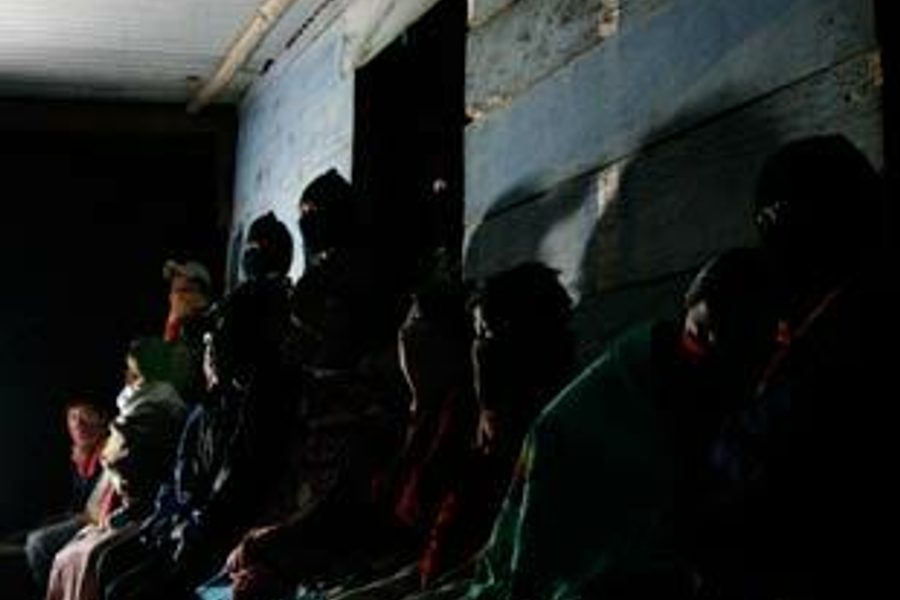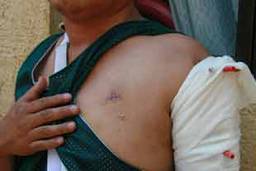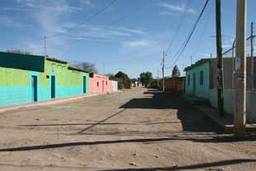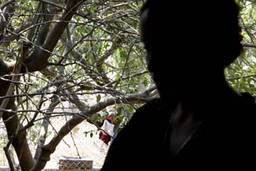
Around 3 p.m. on Jan. 2, nine shots were fired into the air. The perpetrators withdrew, leaving behind a button-down shirt with the cuffs tied to two lone trees in the cornfield. Machetes had hacked the shirt and cut a thick cross into one of the tree trunks at chest height. A bullet case was embedded at the center of the cross.
“This is an example of what they want to do to us,” says José Morales, a 22-year-old Tzeltal Indian who used a pseudonym to protect his identity. “Grab us and hang us from the trees.” Morales is a member of the Zapatista community of Bolon Ajaw, one of dozens of Zapatista communities across the southern state of Chiapas facing almost daily attacks, land invasions and death threats.
After hearing the gunshots, Pedro Alvarez, another member of the community who also preferred to use a pseudonym, had run down the mile-long path from the cornfield where he was cutting wood, to Bolon Ajaw’s center, a cluster of houses made of old boards, corrugated tin roofs, and dirt floors and none with electricity or running water. Alvarez then led the authorities and five observers back to the cornfield where they found the hanging shirt and the cross freshly cut into the tree.
Since early 2007, aggressions against scores of communities, affecting 800 families and threatening more than 12,000 hectares of Zapatista-controlled territory, have taken place, reports the Center for Political Analysis and Social and Economic Investigation (CAPISE), which is based in San Cristobal de las Casas in Chiapas.
“This is clearly a systematic counterinsurgency strategy,” says Ernesto Ledesma, director of CAPISE. “We haven’t seen an offensive this intense for at least 10 years.”
During the last half of 2007, Ledesma and a handful of CAPISE staff and volunteers have released an average of three reports a month documenting the new “government onslaught” against the Zapatista indigenous communities.
“The Mexican state has re-activated paramilitary groups,” says Ledesma. “They are doing what the Spaniards did during the conquest and what the ranchers and local mafias did after the Mexican Revolution: They are dispossessing once again the indigenous peoples from their lands, from their territory.”
In 1994, when the Zapatista Army of National Liberation (EZLN) rose up in arms in Chiapas, indigenous insurgents forced the ranchers from the land and became collective owners of the very fields they worked as slaves for hundreds of years. Since then, the EZLN has resettled thousands of landless people on former haciendas, a process the Zapatistas call “recuperating the land.”
In 1996, the Mexican government signed the San Andres Accords with the EZLN, recognizing indigenous regional autonomy. But the government then balked after signing and never implemented the accords.
On Dec. 22, 1997, 45 Tzotzil indigenous people in Acteal, 2 hours north of San Cristobal, were massacred by the paramilitary group, Peace and Justice (Paz y Justicia), and the impunity that followed led the EZLN to suspend all dialogue with the government.
Then, five years later, the government passed a gutted version of the accords that rejected indigenous regional autonomy and instead further subjected Mexico’s estimated 10 million indigenous citizens to federal authority by defining them as “entities of public interest,” in the text of the law.
As a result, the EZLN cut off communication with the government and set about implementing the accords on its own, creating autonomous municipalities and regional governance structures based on rotating councils of local villagers elected in open assemblies. Road signs throughout Chiapas announce to travelers: “You are now entering autonomous, rebel territory.”
Throughout his six-year term (2000−2006), former Mexican President Vicente Fox built on the previous administrations’ attempts to divide Zapatista communities by using handouts and governmental assistance programs. Fox, like his predecessors, also tried to create and train anti-Zapatista paramilitary groups to masquerade as rural indigenous rights organizations, such as the Organization for the Defense of Indigenous and Peasant Peoples (OPDDIC).
Now, with many communities divided between pro- and anti-Zapatista, organizations like OPDDIC are using government aid programs to get land grants to Zapatista territories. Once the government provides the grants, OPDDIC would have a “legal” pretext to dispossess the Zapatista families from their lands.
The Zapatistas, in turn, refuse to enter into government aid programs, and they refuse to leave the land.
“We spilled our blood for the land, not for a government handout,” says one member of the Zapatista autonomous municipality of San Manuel, which is also under threat.
Meanwhile, the Mexican army has built 56 military bases in Zapatista regions, surrounding communities that support the EZLN, and often providing aid to OPDDIC and other anti-Zapatista organizations.
Morales of Bolon Ajaw says that the aggressions began in 2006 when OPDDIC began to recruit among government sympathizers in the area.
“They are not doing this alone,” he says, “they come on behalf of the government. Whenever there is a problem, the helicopters and police come right away, as if they already knew what was going to happen.”
Over the past four months, according to CAPISE reports and local press accounts, in Bolon Ajaw alone, the OPDDIC has ambushed Zapatista villagers with guns and machetes, badly beating four people.
In response to attacks in late November, CAPISE organized observation brigades to camp out in Bolon Ajaw and other communities to document aggression and threats against the Zapatistas.
“This is a new onslaught of the Mexican state, with all levels of government participating,” says CAPISE’s Ledesma. “They are going for the land. They are going for territory and all the natural resources therein. But now there is an entire movement and indigenous peoples opposed to their project and, moreover, developing another, alternative project, autonomous and their own.”









